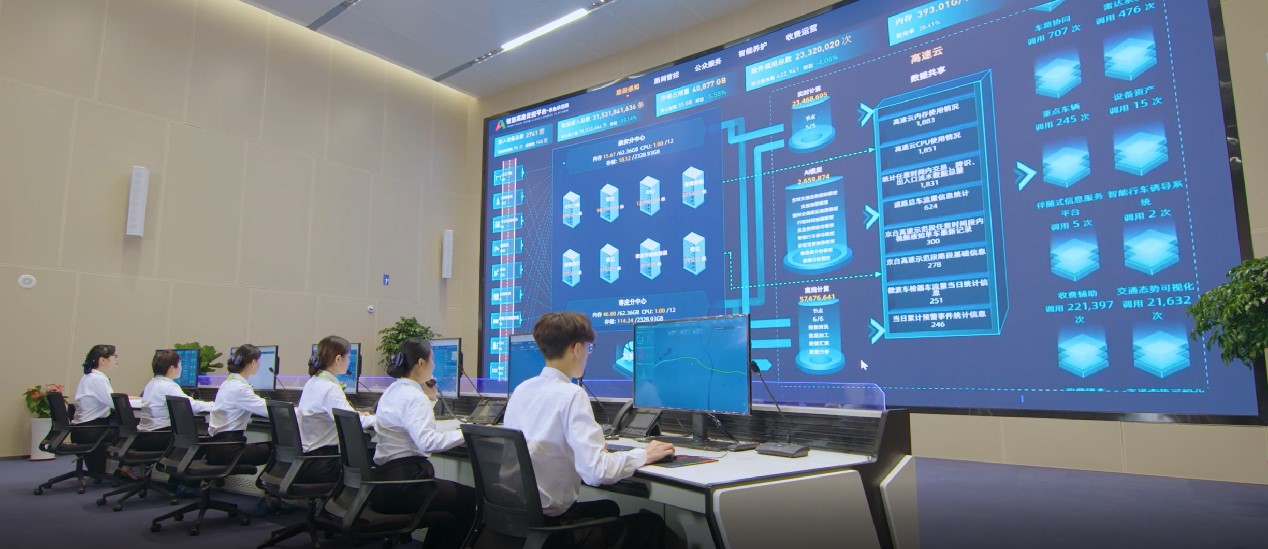Smart expressway in China makes travel more convenient, faster, safer

Photo shows a bird’s-eye view of Beijing-Taipei expressway, a smart expressway that is expected to link Beijing and Taipei, southeast China’s Taiwan, upon completion. (Photo/Courtesy of Shandong Hi-Speed Group)
Thanks to intelligent transformation, a section of the Beijing-Taipei expressway, a partially completed smart expressway that will connect Beijing and Taipei, southeast China’s Taiwan, has seen its monthly average number of traffic accidents decrease by 40.9 percent from 66 to 39, and the average handling time of accidents drop from 28 minutes to 19 minutes, with the accident handling efficiency increasing by 32.1 percent.
High-definition surveillance cameras have been installed at 182 points on the section of the expressway, which links Tai’an city and Zaozhuang city in east China’s Shandong province, according to Li Tao, deputy manager of the engineering department of Shandong Hi-Speed Construction Management Group Co., Ltd., a subsidiary of Chinese construction company Shandong Hi-Speed Group Co., Ltd. (SDHS).

Staff members of a dispatch center of Beijing-Taipei expressway, a smart expressway that is expected to link Beijing and Taipei, southeast China’s Taiwan, are busy with work. (Photo by Li Rui/People’s Daily)
The section also features 15 omnidirectional millimeter-wave radars, 287 directional millimeter-wave radars, and other devices that can collect traffic information in real-time, Li told People’s Daily.
“This square box might seem unimpressive, but it can send information about road conditions and traffic to intelligent connected vehicles (ICVs) to provide real-time guidance for drivers,” said Li, pointing to a small square box attached to poles planted every 200 meters along the section.
With the help of the square box, ICVs can rapidly find parking spaces in expressway service areas. For instance, as ICVs approach the service area in Ningyang county, Tai’an city, along the Beijing-Taipei expressway, the screen of their automotive navigation system automatically displays the number of parking spots available in the service area in the top right-hand corner and guides vehicles there.
After vehicles get onto the sidewalks of the service area, intelligent road spikes flash automatically to remind vehicles to avoid pedestrians.
The application of various intelligent equipment and devices in the service area has upgraded people’s travel experience, enabling them to enjoy contactless payment, automatic payment as well as a vast array of individualized services covering dining, shopping, refueling, car wash, and other needs.
The dispatch center of the Beijing-Taipei highway has benefited from intelligent technology that has reduced their burden and increased their job efficiency.
After the alarm went off in a dispatch center of the Beijing-Taipei expressway in Shandong province, the intelligent management platform of the dispatch center immediately informed the road management authority of parking violations. Within 10 minutes, staff members were on the scene to tow the illegally parked vehicle to the nearest exit.
“Before the intelligent transformation, we had to check the surveillance cameras one by one through manual work during inspection of the expressway, which was time-consuming and usually inefficient,” said Chen Yu, deputy director of the dispatch center operated by Shandong Hi-Speed Co., Ltd., a subsidiary of SDHS.
According to Chen, today, high-definition surveillance cameras, millimeter-wave radars, and other devices installed along the expressway can closely monitor the road 24 hours a day and transmit relevant information to the dispatch center.
The Tai'an-Zaozhuang section of the Beijing-Taipei expressway is the first of its kind in China to completely open to traffic. It was constructed as a trial project in response to aspirations to develop a country with great transport strength. The project combining intelligent transformation and expansion also represents the first smart expressway pilot project in Shandong province.
Through the intensive application of new-generation technologies, including 5G, the BeiDou Navigation Satellite System, big data, and artificial intelligence (AI), the section has not only ensured traffic safety and smooth traffic flows but optimized drivers’ travel experience.
Nevertheless, the massive data generated by the application of new technologies has also posed higher requirements to the dispatch center, the “brain” of the expressway.
Algorithms hold the key to quick and correct reaction of the “brain”. “With the help of algorithms, we have realized second-level monitoring. Our system can detect problems intelligently and send the alarm and early warning automatically, effectively improving inspection efficiency,” said Chen.
Chen told People’s Daily that whenever a vehicle breaks down, the dispatch center can locate the vehicle within 10 seconds, inform road management authority of the situation in time, and send notice to passing vehicles through radio and navigation system to avoid secondary accidents.
The smart “brain” can not only sense and handle traffic accidents, but predict weather conditions and deal with relevant situations in time.
“We have installed ground sensors and other devices along the expressway, which help collect accurate information about the environment of every kilometer of the road and include more than 10 meteorological indicators, such as visibility and precipitation, into the monitoring scope of the intelligent management platform so that it can automatically make decisions about different situations,” said Lyu Xinjian, director of the intelligent transformation and expansion project office of the Tai’an-Zaozhuang section of the Beijing-Taipei expressway.

Beijing-Taipei expressway, a smart expressway that is expected to link Beijing and Taipei, southeast China’s Taiwan, upon completion. (Photo/Courtesy of Shandong Hi-Speed Group)
When the snow removal devices sense accumulated snow on the road surface, they automatically start sprinkler facilities, which can clear snow off road at least 30 minutes faster than melting snow by sprinkling salt artificially, thus effectively avoiding traffic congestion in rainy and snowy days, Lyu said.
A total of more than 30 kinds of such application scenarios of smart technologies have been realized on the Beijing-Taipei expressway.
“After continuous efforts, we have established a complete technology system that can inspire the exploration of smart expressway construction in Shandong and even the entire country,” said Zhang Wei, deputy director of the engineering management department of SDHS.
Research results achieved during the construction and intelligent transformation of the Beijing-Taipei expressway project have been included in more than 20 sets of industrial, local, and organizational standards, and experience in the construction of the project has been applied to that of a smart expressway linking Jinan city and Weifang city of Shandong province, according to Zhang.
“The costs of the application of technologies will gradually drop as relevant links improve day by day. We are also working on the research, development, and application of sensing technology featuring a longer life span and lower energy consumption,” said Lyu.

Photo shows a dispatch center of Beijing-Taipei expressway, a smart expressway that is expected to link Beijing and Taipei, southeast China’s Taiwan. (Photo/Courtesy of Shandong Hi-Speed Group)
Photos
Related Stories
- Smart expressway in E China’s Shandong guarantees convenient, safe travel experience
- China's toll stations closed due to epidemic have mostly resumed operation
- Expressway opens to traffic in SW China's Guizhou
- New Chuxiong-Dali Expressway in Yunnan opened to traffic
- 1st desert expressway in Ningxia opens to traffic
Copyright © 2022 People's Daily Online. All Rights Reserved.









